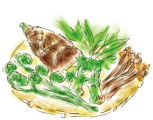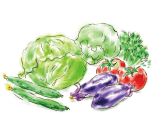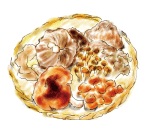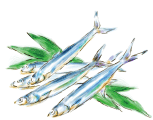HOME > Lake Yamanaka Resort Area
Lake Yamanaka is the closest lake to Mt. Fuji. The nearby Lake Yamanaka resort area has a history of more than 80 years. It is known as a bountiful resort area with a wide range of leisure and convenient facilities in addition to abundant nature. One can say that Lake Yamanaka is an appealing vacation home area because of its perfect balance of all required elements including access, nature, climate, and living environment. Here, we will introduce some of the features of Lake Yamanaka.

Lake Yamanaka has the highest elevation of the Fuji Five Lakes and the third-highest elevation of any lake in Japan. The surface of the lake is 982 meters above sea level, while the Lake Yamanaka resort area on the southern shore has an average elevation of around 1,000 meters. For that reason, the climate is very pleasant. It is roughly five to six degrees Celsius cooler than Tokyo, with an average temperature of around 20°C in the summer.
Like other vacation home areas in the highlands, snow falls three to four times during the winter season. The roads are plowed so chains are unnecessary as long as you have nonskid tires.
Approximately 6,000 people in 2,000 households live at Lake Yamanaka. (As of January 2006)

The natural world near Mt. Fuji and Lake Yamanaka brings many blessings to the people who live in the area. There are opportunities to interact with nature in all parts of daily life, including the hiking courses around Lake Yamanaka, verdant forests, mountain streams, unusual wild grasses, and wild birds. You can also see Whooper Swans on the lake shore; this area is said to be the southern limit of swan migration. Lake Yamanaka, which looks different in all four seasons, is truly a treasure trove of nature.

The surrounding area includes facilities that are convenient for daily life as well as unique shops. The area near Lake Yamanaka is also very appealing; there are many sightseeing spots at the Fuji Five Lakes including Oshino Village (which is famous for the Oshino Hakkai ponds), Fujiyoshida, and Lake Kawaguchi.


Lake Yamanaka is the biggest of the Fuji Five Lakes and has a large surface of approximately 6.46 square kilometers. It is 982 meters above sea level, the third-highest elevation of any lake in Japan. It has a cool climate with an average temperature of about 20°C even during midsummer. This location also offers beautiful views of world-famous Mt. Fuji, a sacred mountain, that defy description. For these reasons, Lake Yamanaka has grown into one of Japan’s foremost resort areas.
This land on the southern shore of the lake, which was previously part of the domain of the Emperor of Japan, was leased from Yamanashi Prefecture. Lots were sold off starting in 1927. Almost 90 years have passed since these lots at the Fujikyu Lake Yamanaka resort area were first subdivided for vacation homes.
The Fuji Golf Course, which allows you to play golf while gazing at Mt. Fuji, is located inside the vacation home area. Many people from political and business circles built vacation homes at the same time. However, the natural world is still mostly preserved in this area, making it different from other vacation home areas where many trees are cut down and partitions are established.
Although this is a vacation home area, it is also designated as a national park in the Mt. Fuji area and there are strict regulations in place including felling trees and the outside appearance, height, and size of vacation homes.
For that reason, the vacation homes that have been constructed seem to blend into nature and place great importance on harmony with the natural world. Wild birds come to the terraces in the morning and you can see deer slowly crossing the road during the winter.
Of course the vacation home area includes water service for drinking water, which is entirely sourced from underground water from Mt. Fuji.
The owners of these vacation homes enjoy fulfilling lifestyles on the weekends drinking delicious water, being surrounded by trees that have different appearances throughout all four seasons, and gazing at magnificent views of Mt. Fuji.
| 1927 | Land at the foot of Mt. Fuji owned by the prefecture was leased |
|---|---|
| 1928 | Construction work began to build the vacation home area |
| 1929 | Rental vacation homes on Lake Yamanaka were constructed |
| 1930 | Full-scale loaning and promotion of the vacation home area was started Twenty-three rental vacation homes on Lake Yamanaka were completed |
| 1933 | Soho Tokutomi (one of Japan’s foremost journalists from the Meiji to Showa periods) named the entrance to the vacation homes along the lake “Asahigaoka” |
| 1935 | The Fuji Golf Course was opened |
| 1936 | Designation of Fuji-Hakone National Park |
| 1963 | Hotel Mt. Fuji was opened Expressway bus service began between Shinjuku and Lake Yamanaka |
| 1976 | A bus terminal was completed at Asahigaoka on the shore of Lake Yamanaka A new clubhouse was constructed at the Fuji Golf Course |
| 1981 | The Yamanakako Road Race began |
| 1986 | The Higashi-Fujigoko Road was opened (between Lake Kawaguchi and Lake Yamanaka) |
| 1989 | The Higashi-Fujigoko Road was opened (between Lake Yamanaka and Subashiri) |
| 2000 | The Fujikyu Resort Amenity Sales Office was built |
| 2006 | Asahigaoka Mori no Eki was opened PICA Lake Yamanaka Village was opened |
| 2010 | Shuttle bus service for vacation home owners began during the summer season |
The Fujikyu Lake Yamanaka resort area is a vacation home area that was leased by Fujikyu all at once from Yamanashi Prefecture, the owner, and is subleased to individual customers. These stable rights can be renewed at the end of the contract (30 years for new contracts). In Japan, there are laws to fully protect the owners of buildings on leased land. The owner is an administrative organization, so these are some of the most stable rights in Japan and there will of course be no forced requisition by the administrative organization.
Lake Yamanaka has the largest area among the Fuji Five Lakes. Located at the foot of the mountain, is also the highest with an elevation of 980 meters. Many people enjoy searching for mountain vegetables and mushrooms in the plains and forests near the lake, and are surprised by the richness of the seasons at the foot of Mt. Fuji. You can enjoy delicious flavors in all four seasons, including the spring with beautiful new greenery, refreshing summer, colorful autumn, and silver-white winter.
Spring

After the snow begins to melt, Giant Butterbur is the first mountain vegetable you will see in early spring. When the new green leaves are visible you can find bracken and Japanese Flowering Fern, as well as Ostrich Fern by the waterside. There are also other mountain vegetables such as Japanese Angelica-tree and Japanese Spikenard. As you enjoy the spring, only take what you can eat to ensure there are plenty of these vegetables left.
Summer

The area at the foot of Mt. Fuji near Lake Yamanaka has a cool climate and is known as a prominent production area for highland vegetables. You’ll be amazed by the fresh flavor of vegetables that were just harvested. You can discover anew the rich flavor of familiar vegetables like lettuce, tomato, corn, and carrots.
Autumn

Strolling through the colorful forest and looking for mushrooms is an activity that can only be enjoyed in the autumn. There are many edible mushrooms at the mountain’s foot, but they are difficult to tell apart. In this region they may also be called different names from books, so the safest way is for first-time mushroom gatherers to go together with a local expert. Contact Yamanakako Village or the Imperial Award Forest Association for more information.
Winter

Fishing for wakasagi (smelt) is a unique part of the winter season at Lake Yamanaka. People dig holes in the frozen lake surface or use boats when it isn’t frozen. There are specialty shops on the lake shore and in the surrounding area that serve dishes such as tempura and candied fish made from freshly caught wakasagi—delicious foods that can only be enjoyed in the winter.
| Fujikyu Asahigaoka Bus Terminal | This bus terminal is a central location for sightseeing at Lake Yamanaka and is the last stop on the bus to Lake Yamanaka. [Address] Asashigaoka, Yamanakako-mura, Minamitsuru-gun, Yamanashi Prefecture [Telephone] 0555-62-2135 |
|---|---|
| Fuji Golf Course | [Address] 262−1 Yamanaka, Yamanakako-mura, Minamitsuru-gun, Yamanashi Prefecture [Telephone] 0555-62-1227 [Website] http://www.fuji-gc.com/ |
| Hotel Mt. Fuji | A hotel built solely for views of Mt. Fuji [Address] 1360-83 Yamanaka, Yamanakako-mura, Minamitsuru-gun, Yamanashi Prefecture [Telephone] 0555-62-2111 [Website] http://www.mtfuji-hotel.com/ |
| Benifuji no Yu | [Hours] 10:00 a.m. – 9:00 p.m. (last entry at 8:30 p.m.) *December – February (weekends and public holidays only): open from 6:00 a.m. [Regular holiday] Every Tuesday (however, open on Tuesdays that are public holidays, during Golden Week, from July to September, and the New Year holidays) [Address] 865-776 Yamanaka, Yamanakako-mura, Minamitsuru-gun, Yamanashi Prefecture [Telephone] 0555-20-2700 [Website] http://www.benifuji.co.jp/ |
| Ishiwari-no-yu | [Hours] 10:00 a.m. – 9:00 p.m. (last entry at 8:30 p.m.) [Regular holiday] Every Thursday (excluding public holidays and July through August) [Address] 1450 Hirano, Yamanakako-mura, Minamitsuru-gun, Yamanashi Prefecture [Telephone] 0555-20-3355 [Website] http://www.ishiwarinoyu.jp/ |
| Keiyo D2 Yoshida Branch Fuji | [Hours] 9:30 a.m. – 7:30 p.m. [Address] 2324-3 Shimoyoshida, Fujiyoshida-shi [Telephone] 0555-30-0160 [Website] http://www.keiyo.co.jp/store/detail.php?sid=131 |
| Cainz Home Fuji Yoshida Branch | [Hours] 9:30 a.m. – 8:00 p.m. [Address] 3200 Kamiyoshida, Fujiyoshida-shi, Yamanashi Prefecture [Telephone] 0555-30-0333 [Website] http://sasp.mapion.co.jp/b/cainz/info/248/ |
| Selva Oshino Branch (A large supermarket with a sales space of roughly 924 square meters) |
A large supermarket with a sales space of roughly 924 square meters [Hours] 10:00 a.m. – 9:00 p.m. [Address] 1405 Shibokusa, Oshino-mura, Minamitsuru-gun, Yamanashi Prefecture [Telephone] 0555-20-5311 [Website] http://sun-selva.co.jp/store/oshino |